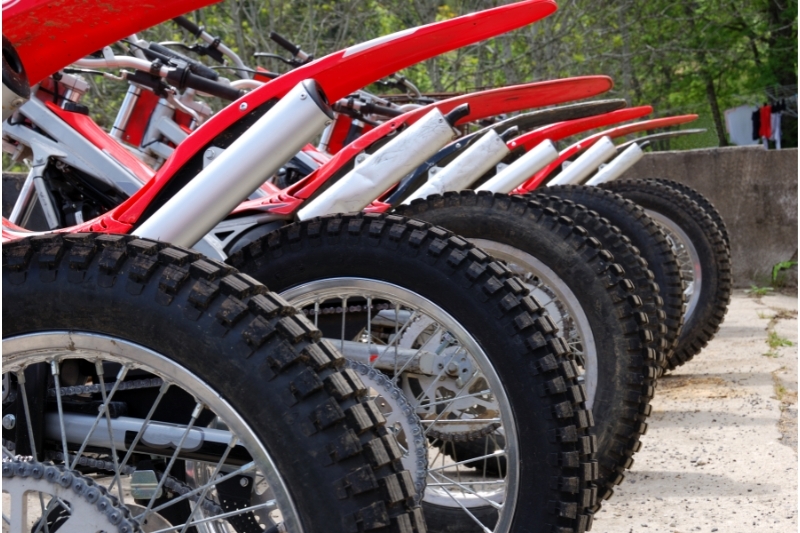The ability to tackle rugged terrain, explore untamed landscapes, and push the boundaries of what a motorcycle can do is truly exhilarating. In this comprehensive guide, I’ll share my expertise and insights to help you unleash your own off-road motorcycle adventure.
Off-road motorcycles, also known as dual-sport or adventure bikes, are designed to handle a wide range of terrain, from paved roads to dirt trails, gravel paths, and even challenging off-road conditions. These versatile machines offer a unique riding experience that combines the agility and responsiveness of a street bike with the ruggedness and capability of an off-road machine.
The Benefits of Off-Road Riding
Embarking on an off-road motorcycle adventure offers a multitude of benefits. Firstly, it allows you to explore the great outdoors and discover hidden gems that are inaccessible by traditional means. The sense of freedom and connection with nature is unparalleled, as you navigate through winding trails, scenic vistas, and remote destinations.
Moreover, off-road riding is an excellent way to challenge yourself and hone your riding skills. Navigating through rough terrain, managing traction, and adapting to changing conditions requires a heightened level of concentration, reflexes, and technique. This not only enhances your overall riding proficiency but also boosts your confidence and problem-solving abilities.
Choosing the Right Off-Road Motorcycle
Selecting the appropriate off-road motorcycle is crucial to ensure a safe and enjoyable riding experience. When it comes to choosing the right bike, there are several factors to consider, such as:
- Engine Displacement: Off-road motorcycles come in a range of engine sizes, from smaller, lightweight models to larger, more powerful options. Consider your riding style, terrain, and experience level to determine the optimal engine displacement for your needs.
- Suspension and Handling: Look for bikes with robust, adjustable suspension systems that can handle the demands of off-road riding. The bike’s overall handling characteristics, such as agility, stability, and maneuverability, are also essential.
- Fuel Capacity and Range: Longer off-road excursions may require a bike with a larger fuel tank and better fuel efficiency to extend your range and reduce the need for frequent refueling stops.
- Weight and Ergonomics: The weight of the motorcycle, as well as its ergonomic features, such as seat height, handlebar positioning, and rider comfort, can significantly impact your riding experience and control.
To assist you in making an informed decision, I recommend researching and test-riding various off-road motorcycle models to find the one that best suits your needs and riding preferences.
Off-Road Motorcycle Gear and Accessories
Proper gear and accessories are crucial for safe and comfortable off-road riding. The right protective equipment can help mitigate the risks associated with the unpredictable nature of off-road terrain. Essential gear includes:
- Helmet: A full-face or modular helmet with DOT or ECE certification provides comprehensive protection for your head.
- Riding Jacket and Pants: Look for jackets and pants made of durable, abrasion-resistant materials, such as leather or high-quality textile, with impact-absorbing armor at key areas.
- Boots: Sturdy, over-the-ankle boots with good traction and ankle support are a must for off-road riding.
- Gloves: Reinforced, breathable gloves can help protect your hands and improve grip on the handlebars.
- Goggles or Riding Glasses: These protect your eyes from dust, debris, and the elements.
In addition to the essential gear, you may also want to consider accessories like GPS navigation systems, communication devices, and luggage options to enhance your off-road experience.
Off-Road Motorcycle Maintenance and Care
Maintaining and caring for your off-road motorcycle is crucial to ensure its longevity and optimal performance. Regular maintenance tasks include:
- Cleaning and Inspection: Thoroughly cleaning your bike after each off-road adventure and inspecting for any damage or wear and tear is essential.
- Lubrication: Regularly lubricating the chain, suspension components, and other moving parts helps prevent premature wear and tear.
- Tire Maintenance: Checking tire pressure, tread depth, and overall condition is critical for maintaining traction and control on off-road terrain.
- Fluid Changes: Adhering to the manufacturer’s recommended schedule for oil, brake fluid, and other fluid changes helps keep your bike in top shape.
- Suspension Adjustments: Adjusting the suspension settings to accommodate different riding conditions and terrain can significantly improve the bike’s handling and comfort.
By staying on top of your off-road motorcycle’s maintenance, you can ensure a safer and more enjoyable riding experience, while also extending the life of your investment.
Essential Off-Road Riding Skills
Mastering the essential off-road riding skills is key to navigating challenging terrain with confidence and control. Some of the critical skills to develop include:
- Proper Body Positioning: Maintaining the correct body position, with your weight centered and your knees gripping the tank, can help you maintain balance and control on uneven surfaces.
- Throttle and Clutch Control: Smooth and precise throttle and clutch control are essential for managing traction and momentum on loose or slippery surfaces.
- Braking Techniques: Learning effective braking techniques, such as using the rear brake more than the front on off-road terrain, can help you maintain stability and control.
- Cornering and Turning: Mastering the art of cornering and turning on off-road surfaces requires a combination of body positioning, weight transfer, and throttle control.
- Obstacle Negotiation: Developing the skills to navigate over logs, rocks, and other obstacles safely is crucial for navigating challenging off-road trails.
Regularly practicing these skills, either on a dedicated off-road training course or in controlled environments, can greatly enhance your confidence and ability to tackle any off-road challenge.
Exploring Off-Road Trails and Destinations
One of the most exciting aspects of off-road motorcycle riding is the opportunity to explore new and uncharted territories. From remote wilderness areas to scenic mountain trails, the world of off-road riding offers a wealth of adventure and discovery.
When planning your off-road excursions, consider the following:
- Research and Planning: Thoroughly research the terrain, weather conditions, and any legal or regulatory requirements for the areas you plan to explore.
- Navigation and Mapping: Invest in a reliable GPS or navigation system, and familiarize yourself with the trail maps and route options.
- Ride with a Group: Joining a local off-road motorcycle club or organizing group rides can enhance the experience and provide additional safety and camaraderie.
- Respect the Environment: Always practice responsible and sustainable riding, adhering to designated trails and leaving no trace behind.
By carefully planning and executing your off-road adventures, you can unlock a world of breathtaking landscapes, unique experiences, and unforgettable memories.
Off-Road Motorcycle Events and Competitions
The off-road motorcycle community is vibrant and active, with a variety of events and competitions that cater to riders of all skill levels. These events offer an opportunity to connect with like-minded enthusiasts, test your skills, and immerse yourself in the thrill of off-road riding.
Some popular off-road motorcycle events and competitions include:
- Enduro Races: These multi-stage events challenge riders’ endurance, technical skills, and navigation abilities over long, rugged courses.
- Dual-Sport Rallies: These organized rides combine on-road and off-road segments, allowing riders to explore a variety of terrain.
- Adventure Bike Challenges: These events test the capabilities of adventure-style motorcycles and the riders’ problem-solving skills in diverse off-road conditions.
- Motocross and Supercross: These high-intensity, closed-circuit races showcase the athleticism and skill of off-road motorcycle racers.
Participating in these events, whether as a competitor or a spectator, can be a fantastic way to expand your off-road riding knowledge, connect with the community, and push the boundaries of your own riding abilities.
Off-Road Motorcycle Safety Tips
Safety should always be the top priority when embarking on off-road motorcycle adventures. Here are some essential safety tips to keep in mind:
- Wear Proper Gear: Ensure you are equipped with a DOT-approved helmet, sturdy riding jacket and pants, boots, and gloves to protect yourself in the event of a fall or collision.
- Ride Within Your Limits: Do not attempt to tackle terrain or obstacles that exceed your skill level. Gradually build up your experience and confidence.
- Inspect Your Bike: Thoroughly inspect your motorcycle before each ride, checking for any mechanical issues or wear and tear that could compromise your safety.
- Carry Emergency Supplies: Pack essential items like a first-aid kit, tools, and a means of communication in case of emergencies or breakdowns.
- Ride Responsibly: Respect the environment, obey all local regulations, and be mindful of other trail users to ensure a safe and enjoyable experience for everyone.
By prioritizing safety and exercising caution, you can minimize the risks associated with off-road riding and focus on the pure thrill and adventure that it offers.
Conclusion: Start Your Off-Road Motorcycle Adventure
In this comprehensive guide, we’ve explored the world of off-road motorcycles, delving into the benefits, equipment, maintenance, and essential skills required to embark on your own adventure. Whether you’re a seasoned off-road enthusiast or a newcomer to the sport, We hope this guide has provided you with the knowledge and inspiration to embrace the thrill and freedom of off-road riding.





